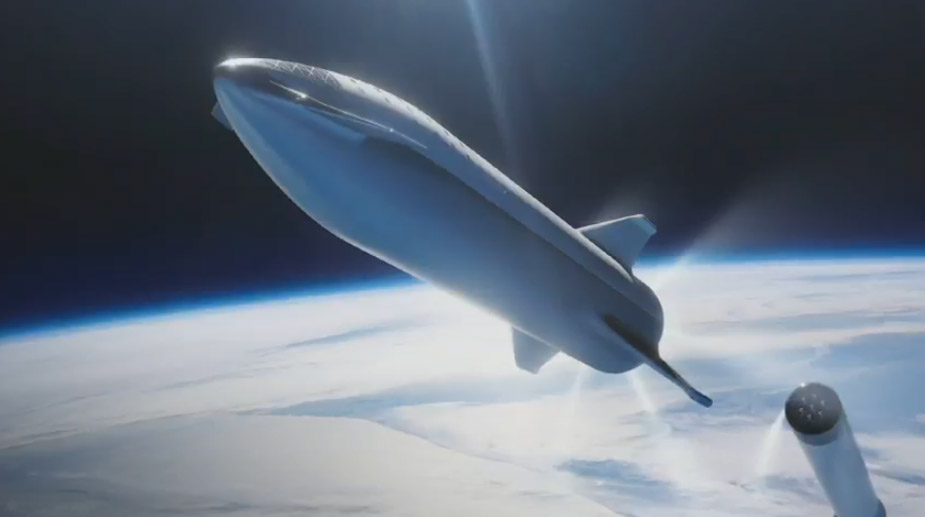
We won't have to wait much longer for our next update about SpaceX's Mars-colonizing spaceship, which the company calls Starship.
SpaceX founder and CEO Elon Musk had promised that he'd unveil the latest Starship design changes after the vehicle's stubby test-flight prototype, known as Starhopper, completed its first untethered hop.
That milestone occurred last week at SpaceX's South Texas facility in Boca Chica, so the update will be coming soon — probably by mid-August, Musk said over the weekend.
Related: SpaceX's Starship and Super Heavy Mars Rocket in Pictures
"Now that Hopper has flown, Starship update probably in two weeks or so," the billionaire entrepreneur wrote on Twitter Sunday (July 28).
Musk first outlined a detailed Starship design in September 2016, during a talk at the annual International Astronautical Congress (IAC) in Mexico (though he had discussed a "Mars Colonial Transporter" architecture more vaguely previously). Back then, the reusable 100-passenger vehicle and the huge booster that will launch it from Earth were together called the Interplanetary Transport System (ITS).
Musk summarized SpaceX's latest Mars-colonization thinking at the next IAC meeting, which occurred in Australia in September 2017. He told us then that ITS had become BFR, short for "Big Falcon Rocket." (Technically, the booster was BFR and the spaceship was BFS, short for "Big Falcon Spaceship." But most people just called the whole system BFR.)
Get the Space.com Newsletter
Breaking space news, the latest updates on rocket launches, skywatching events and more!
We got another update in September 2018, when Musk told us that the spaceship-rocket duo would stand 387 feet (118 meters) tall at launch — about 11% taller than previously envisioned. He also revealed, among other things, that the BFS will feature two large "actuated" fins near its tail, to help the vehicle steer through planetary atmospheres for safe landings. A landing leg back there will also be stylized to look like one of those structures, he added, giving the BFS the three-finned look of the rocket flown by the comic-book character Tintin in the 1954 book "Explorers on the Moon."
Two months later, Musk announced another name change: BFS was now Starship, and BFR was to be called Super Heavy.
As currently envisioned, Starship will sport six of SpaceX's next-generation Raptor engines, and Super Heavy will be powered by 35 of them, with slots for two more Raptors if need be. But things could change; we'll have to wait and see what Musk says in the coming design update.
SpaceX sees Starship and Super Heavy eventually performing all of the company's spaceflight duties, from launching satellites to ferrying people to and from the moon and Mars to completing superfast "point-to-point" passenger trips around Earth. As a result, SpaceX plans to eventually phase out its other spaceflight hardware — its workhorse Falcon 9 rocket, the newer, more powerful Falcon Heavy and the cargo and crew versions of its Dragon capsule.
SpaceX aims to launch satellites using Starship and Super Heavy as early as 2021. The first crewed mission, which will send Japanese billionaire Yusaku Maezawa and a handful of artists on a trip around the moon, is targeted for 2023.
Starhopper, which sports a single Raptor, has now left the ground three times. In addition to last week's flight, which Musk said targeted an altitude of about 65 feet (20 m), the vehicle took two brief test hops in early April, remaining tethered to the ground for safety's sake on both occasions.
- See the Evolution of SpaceX's Rockets in Pictures
- Will Elon Musk Fly on SpaceX's Private Moon Flight in 2023 with Japanese Billionaire?
- SpaceX's Raptor Engine Hits Power Level for Starship Launches
Mike Wall's book about the search for alien life, "Out There" (Grand Central Publishing, 2018; illustrated by Karl Tate), is out now. Follow him on Twitter @michaeldwall. Follow us on Twitter @Spacedotcom or Facebook.
Join our Space Forums to keep talking space on the latest missions, night sky and more! And if you have a news tip, correction or comment, let us know at: community@space.com.

Michael Wall is a Senior Space Writer with Space.com and joined the team in 2010. He primarily covers exoplanets, spaceflight and military space, but has been known to dabble in the space art beat. His book about the search for alien life, "Out There," was published on Nov. 13, 2018. Before becoming a science writer, Michael worked as a herpetologist and wildlife biologist. He has a Ph.D. in evolutionary biology from the University of Sydney, Australia, a bachelor's degree from the University of Arizona, and a graduate certificate in science writing from the University of California, Santa Cruz. To find out what his latest project is, you can follow Michael on Twitter.









